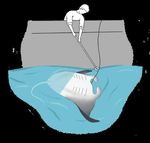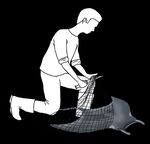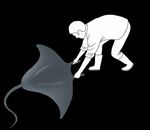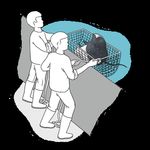Handling and release guidelines for manta and devil rays (mobulids)
←
→
Page content transcription
If your browser does not render page correctly, please read the page content below
Handling and release
guidelines for manta and
devil rays (mobulids)
Mobulids (manta and devil rays) are large
pelagic filter-feeding elasmobranchs that It is prohibited to retain mobulids in the
are found in tropical and subtropical waters IOTC Area of Competence in any fishery
in areas where tuna fishing takes place. They (other than those for subsistence).
are particularly vulnerable to overfishing
due to their extremely slow growth and Following best practice handling and
reproduction and so the Indian Ocean Tuna release guidance will increase the
Commission has banned their retention. survival of mobulids caught incidentally
during fishing operations.
Mobulid rays are fragile and highly
susceptible to internal damage when out of Safety:
the water as they lack protection by a rigid
skeleton. These rays are obligate ventilators, Safety of fishing crew is the priority in all fishing,
which means they must continue swimming handling and release operations. There is no
to ‘breathe’ and therefore may die through danger of a sting from mobulids, though care
suffocation if they remain motionless for should be taken to avoid knocks or blows from
long. Mobulid rays should therefore be kept the wings of medium and large rays. Note that
in the water wherever feasible or, if they rays entangled in nets or lines may appear dead
must be taken aboard, released as quickly and thrash when released.
as possible.Gillnet fisheries Items to have onboard: long-handled net
cutters, stiff filament dipnet/lift net
Do
Medium-to-large rays Small rays
Leave the animal in the water. If it cannot be disentangled in the
water, gently bwn board and cut
• Partial entanglement: slacken the net
away the net.
sufficiently to allow the ray to escape
and carefully manoeuvre the net away.
• Full entanglement: carefully cut the
net away in the water while avoiding
contact with the animal.
Small rays: (up to 30 kg or 1 m width)
Medium rays: (30 - 60 kg or 1 - 2 m width)
Large rays: (over 60 kg or 2 m width)Items to have onboard: long-handled line
Longline fisheries cutters and de-hookers, bolt-cutters, stiff
filament dipnet/lift net
Do Do
Medium-to-large rays Small rays
Leave the animal in the water and If the gear cannot be removed in the
use a dehooker to remove the hook water, carefully bring on board and
or a long-handled line cutter to cut remove by backing the hook out. If
the line as close to the hook as the hook is embedded, either cut the
possible (ideally leaving < 0.5 m of hook with bolt cutters or cut the line
line attached to the ray). at the hook.
Do not
Do not hit Do not attempt
or slam a ray to dislodge a
against the side deeply hooked
of the vessel in or ingested hook
an attempt to by pulling on the
remove a ray line or using a
from the line. dehooker.Purse seine fisheries Items to have onboard: canvas or
net slings and or stretchers
Do
1 If possible release rays
from the net while they
are still free-swimming
(e.g. back down
procedure, dropping
corks).
2 To the extent possible,
brail out of the net
directly.
Large rays that cannot be
3
released safely before being
landed on deck, shall be returned
to the water as soon as possible,
preferably utilizing a ramp from
the deck or net
that is gently
placed under the
animal to ‘sieve’
it from the tuna.
(Images adapted from François Poisson, IFREMER, based on an idea of the skipper and crew of the San Nanumea (Sanford Ltd, New Zealand).Guidelines applicable to ALL fisheries
Do
Leave rays in the water
wherever possible.
Small-to-medium rays
The ray be handled by 2 or 3 people
and carried by the sides of its wings
or using a purpose built cradle/
stretcher, and gently released over
the side of the vessel.
Do Not
Do not drag, pull or carry a ray Do not drag, pull or carry a ray
by its cephalic lobes (“horns”) by inserting your hands into the
or tail. gill slits or spiracles.Do Not
Do not cut the tail or the spine. Do not gaff, hook or spear.
Do not punch holes in the body to Do not leave onboard until hauling is
insert any wire/cable/rope or bind a finished before returning it to the sea or
ray in order to move or lift it. leave in the sun on deck.
The designations employed and the presentation of material in this information Commons licence. If a translation of this work is created, it must include the
product do not imply the expression of any opinion whatsoever on the part of the following disclaimer along with the required citation: “This translation was not
Food and Agriculture Organization of the United Nations (FAO) concerning the legal created by the Food and Agriculture Organization of the United Nations (FAO).
or development status of any country, territory, city or area or of its authorities, or FAO is not responsible for the content or accuracy of this translation. The original
concerning the delimitation of its frontiers or boundaries. The mention of specific [Language] edition shall be the authoritative edition.”
companies or products of manufacturers, whether or not these have been patented,
Disputes arising under the licence that cannot be settled amicably will be resolved by
does not imply that these have been endorsed or recommended by FAO in
mediation and arbitration as described in Article 8 of the licence except as otherwise
preference to others of a similar nature that are not mentioned.
provided herein. The applicable mediation rules will be the mediation rules of the
The views expressed in this information product are those of the author(s) and do World Intellectual Property Organization http://www.wipo.int/amc/en/mediation/
not necessarily reflect the views or policies of FAO. rules and any arbitration will be conducted in accordance with the Arbitration Rules
of the United Nations Commission on International Trade Law (UNCITRAL).
© FAO, 2020
Third-party materials. Users wishing to reuse material from this work that is
attributed to a third party, such as tables, figures or images, are responsible
Some rights reserved. This work is made available under the Creative Commons for determining whether permission is needed for that reuse and for obtaining
Attribution-NonCommercial-ShareAlike 3.0 IGO licence (CC BY-NC-SA 3.0 IGO; permission from the copyright holder. The risk of claims resulting from infringement
https://creativecommons.org/licenses/by-nc-sa/3.0/igo/legalcode/legalcode). of any third-party-owned component in the work rests solely with the user.
Under the terms of this licence, this work may be copied, redistributed and adapted Sales, rights and licensing. FAO information products are available on the FAO
for non-commercial purposes, provided that the work is appropriately cited. In any website (www.fao.org/publications) and can be purchased through publications-
use of this work, there should be no suggestion that FAO endorses any specific sales@fao.org. Requests for commercial use should be submitted via: www.fao.
organization, products or services. The use of the FAO logo is not permitted. If the org/contact-us/licence-request. Queries regarding rights and licensing should be
work is adapted, then it must be licensed under the same or equivalent Creative submitted to: copyright@fao.org.
Designed and developed by Dr Sarah Martin For further information contact: Phone: +248 422 5494
Graphics and layout by Holly Giblin Indian Ocean Tuna Commission Fax: +248 422 4364
Cover photograph © Moazzam Khan Le Chantier Mall Email: IOTC-Secretariat@fao.org
Acknowledgements: with thanks to Dr Daniel Fernando, Dr Guy PO Box 1011 Website: http://www.iotc.org
Stevens and Moazzam Khan for comments on earlier drafts. Victoria
SeychellesYou can also read



























































